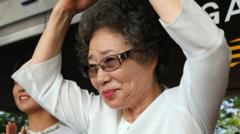Cafes in South Korea, particularly in affluent areas like Daechi, are becoming battlegrounds between traditional coffee shop purposes and the pursuit of study spaces by young patrons dubbed "Cagongjok". Recently enforced guidelines aim to balance the needs of various customers amid growing complaints about overstaying.
The Rise of Cafe Culture: South Korea's "Cagongjok" Faces Growing Scrutiny

The Rise of Cafe Culture: South Korea's "Cagongjok" Faces Growing Scrutiny
As South Korean cafes battle with student patrons over prolonged occupancy, the debate over workspaces and cultural norms heats up.
In affluent neighborhoods like Daechi, Seoul, the local cafe culture is facing challenges as the phenomenon known as "Cagongjok" becomes increasingly prominent. This term refers to the trend of students and young professionals using cafes as study or work environments. Cafe owners, like Hyun Sung-joo from a local Starbucks, recount instances when patrons occupy tables for an entire day with elaborate setups, including multiple laptops and power strips. Hyun has resorted to blocking power outlets to manage prolonged occupancy, living in fear that such practices affect the business viability against soaring rental costs.
The implications of this cultural shift are significant. Unlike Western countries, where cafes serve socialization as much as productivity, the South Korean landscape has grown to accommodate this need for time-efficient study spaces. Recently, Starbucks Korea introduced nationwide guidelines aimed at curbing excessive occupation, while still allowing guidance rather than enforcing strict removal of patrons. The guidelines emerged from a growing concern over unattended belongings, which previously led to instances of theft.
Despite these restrictions, moderate users of the cafes still frequent them for several hours each day, with some students balancing study time with breaks. Mixed reactions from customers reveal a shared need for social space, as more diners express frustration over the lack of available seats due to monopolizing students. Many regular patrons favor the new guidelines; however, some argue Starbucks is straying from its original philosophy that welcomed diverse cafe use.
In response to complaints about empty tables taken up for hours, some independent cafes have adopted varied approaches. While some owners encourage Cagongjok respectfully, others have set strict time limits for study sessions to maintain a balance conducive to conversation and relaxation. Kim, an anonymous cafe owner in Jeonju, employs a "No Study Zone" policy that restricts study time in common areas to combat monopolization.
But the question remains: why are cafes so attractive compared to libraries or home studying? For many, including Yu-jin Mo, cafes provide a refuge from personal struggles. Mo emphasizes the negative associations she has with home, finding comfort in the social atmospheres created in cafes. Professor Choi Ra-young from Ansan University suggests Cagongjok reflects deeper systemic issues within South Korea's competitive society—shaping a need for designated public spaces that can cater to various student needs.
Both cafe owners and educators are calling for more inclusive environments to embrace this evolving aspect of South Korean culture, allowing student patrons to flourish without disrupting others. As the cafe culture continues to grow, finding the right balance remains the essential conversation in the fight for communal spaces in South Korea.
The implications of this cultural shift are significant. Unlike Western countries, where cafes serve socialization as much as productivity, the South Korean landscape has grown to accommodate this need for time-efficient study spaces. Recently, Starbucks Korea introduced nationwide guidelines aimed at curbing excessive occupation, while still allowing guidance rather than enforcing strict removal of patrons. The guidelines emerged from a growing concern over unattended belongings, which previously led to instances of theft.
Despite these restrictions, moderate users of the cafes still frequent them for several hours each day, with some students balancing study time with breaks. Mixed reactions from customers reveal a shared need for social space, as more diners express frustration over the lack of available seats due to monopolizing students. Many regular patrons favor the new guidelines; however, some argue Starbucks is straying from its original philosophy that welcomed diverse cafe use.
In response to complaints about empty tables taken up for hours, some independent cafes have adopted varied approaches. While some owners encourage Cagongjok respectfully, others have set strict time limits for study sessions to maintain a balance conducive to conversation and relaxation. Kim, an anonymous cafe owner in Jeonju, employs a "No Study Zone" policy that restricts study time in common areas to combat monopolization.
But the question remains: why are cafes so attractive compared to libraries or home studying? For many, including Yu-jin Mo, cafes provide a refuge from personal struggles. Mo emphasizes the negative associations she has with home, finding comfort in the social atmospheres created in cafes. Professor Choi Ra-young from Ansan University suggests Cagongjok reflects deeper systemic issues within South Korea's competitive society—shaping a need for designated public spaces that can cater to various student needs.
Both cafe owners and educators are calling for more inclusive environments to embrace this evolving aspect of South Korean culture, allowing student patrons to flourish without disrupting others. As the cafe culture continues to grow, finding the right balance remains the essential conversation in the fight for communal spaces in South Korea.



















